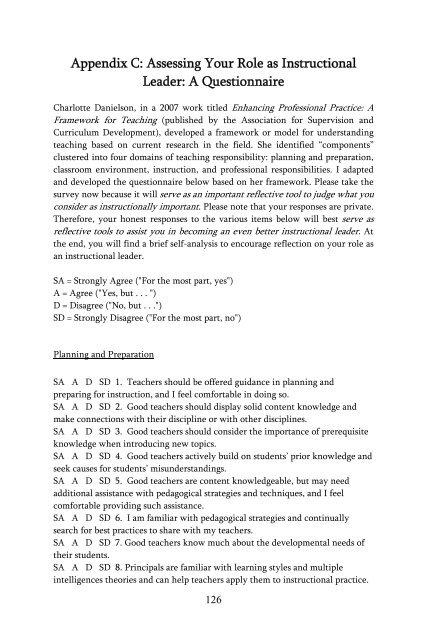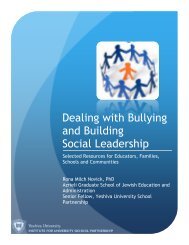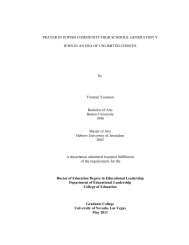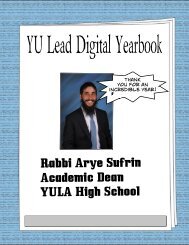Improving Instructional Quality in Jewish Day Schools and Yeshivot ...
Improving Instructional Quality in Jewish Day Schools and Yeshivot ...
Improving Instructional Quality in Jewish Day Schools and Yeshivot ...
You also want an ePaper? Increase the reach of your titles
YUMPU automatically turns print PDFs into web optimized ePapers that Google loves.
Appendix C: Assess<strong>in</strong>g Your Role as <strong>Instructional</strong>Leader: A QuestionnaireCharlotte Danielson, <strong>in</strong> a 2007 work titled Enhanc<strong>in</strong>g Professional Practice: AFramework for Teach<strong>in</strong>g (published by the Association for Supervision <strong>and</strong>Curriculum Development), developed a framework or model for underst<strong>and</strong><strong>in</strong>gteach<strong>in</strong>g based on current research <strong>in</strong> the field. She identified “components”clustered <strong>in</strong>to four doma<strong>in</strong>s of teach<strong>in</strong>g responsibility: plann<strong>in</strong>g <strong>and</strong> preparation,classroom environment, <strong>in</strong>struction, <strong>and</strong> professional responsibilities. I adapted<strong>and</strong> developed the questionnaire below based on her framework. Please take thesurvey now because it will serve as an important reflective tool to judge what youconsider as <strong>in</strong>structionally important. Please note that your responses are private.Therefore, your honest responses to the various items below will best serve asreflective tools to assist you <strong>in</strong> becom<strong>in</strong>g an even better <strong>in</strong>structional leader. Atthe end, you will f<strong>in</strong>d a brief self-analysis to encourage reflection on your role asan <strong>in</strong>structional leader.SA = Strongly Agree ("For the most part, yes")A = Agree ("Yes, but . . . ")D = Disagree ("No, but . . .")SD = Strongly Disagree ("For the most part, no")Plann<strong>in</strong>g <strong>and</strong> PreparationSA A D SD 1. Teachers should be offered guidance <strong>in</strong> plann<strong>in</strong>g <strong>and</strong>prepar<strong>in</strong>g for <strong>in</strong>struction, <strong>and</strong> I feel comfortable <strong>in</strong> do<strong>in</strong>g so.SA A D SD 2. Good teachers should display solid content knowledge <strong>and</strong>make connections with their discipl<strong>in</strong>e or with other discipl<strong>in</strong>es.SA A D SD 3. Good teachers should consider the importance of prerequisiteknowledge when <strong>in</strong>troduc<strong>in</strong>g new topics.SA A D SD 4. Good teachers actively build on students’ prior knowledge <strong>and</strong>seek causes for students’ misunderst<strong>and</strong><strong>in</strong>gs.SA A D SD 5. Good teachers are content knowledgeable, but may needadditional assistance with pedagogical strategies <strong>and</strong> techniques, <strong>and</strong> I feelcomfortable provid<strong>in</strong>g such assistance.SA A D SD 6. I am familiar with pedagogical strategies <strong>and</strong> cont<strong>in</strong>uallysearch for best practices to share with my teachers.SA A D SD 7. Good teachers know much about the developmental needs oftheir students.SA A D SD 8. Pr<strong>in</strong>cipals are familiar with learn<strong>in</strong>g styles <strong>and</strong> multiple<strong>in</strong>telligences theories <strong>and</strong> can help teachers apply them to <strong>in</strong>structional practice.126










